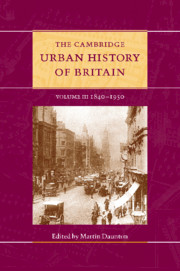Book contents
- Frontmatter
- 1 Introduction
- Part I Circulation
- 2 Urban networks
- 3 Modern London
- 4 Ports
- 5 The development of small towns in Britain
- 6 Migration
- 7 Pollution in the city
- 8 From Shillibeer to Buchanan: transport and the urban environment
- Part II Governance
- Part III Construction
- Part IV Getting and spending
- Part V Images
- Select bibliography
- Index
- Plates 1-7
- Plates 8-14
- Plates 15-20
- Plates 21-27
- Plates 28-34
- Plates 35-41
- Plates 42-48>
- Plates 49-53
- References
6 - Migration
from Part I - Circulation
Published online by Cambridge University Press: 28 March 2008
- Frontmatter
- 1 Introduction
- Part I Circulation
- 2 Urban networks
- 3 Modern London
- 4 Ports
- 5 The development of small towns in Britain
- 6 Migration
- 7 Pollution in the city
- 8 From Shillibeer to Buchanan: transport and the urban environment
- Part II Governance
- Part III Construction
- Part IV Getting and spending
- Part V Images
- Select bibliography
- Index
- Plates 1-7
- Plates 8-14
- Plates 15-20
- Plates 21-27
- Plates 28-34
- Plates 35-41
- Plates 42-48>
- Plates 49-53
- References
Summary
INTRODUCTION
Migrants have been a ubiquitous and, at times, a dominant presence in modern British cities. In 1851, for example, in almost all the great towns, newcomers outnumbered natives and, among the adult population, the migrant majority was overwhelming. In cities such as Manchester, Bradford and Glasgow, more than 75 per cent of the population over the age of twenty had been born elsewhere and more generally in urban Britain the proportion was over 66 per cent. The growth of suburban Britain in the interwar years also gave rise to settlements in which the migrant presence was spectacular. The population of Hendon, for instance, more than doubled between 1921 and 1931 to reach 116,000 and migration accounted for 92 per cent of the increase.
The differences between these two movements – mid-nineteenth-century migration to industrial and commercial centres and migration out of cities into suburbs in the twentieth century – should alert us to a further feature of migrants in modern Britain: namely, their dazzling heterogeneity. A preliminary inventory of migrants would necessarily enumerate the migrant contribution to the mid-nineteenth-century industrial labour force, as well as the fundholders and annuitants who congregated in county towns; it would include both village girls sent away from home into domestic service, as well as their employers – Victorian suburban and small-town householders in flight from the environmental and social disorder of large cities; it would take note of nineteenth-century artisans moving through well-established tramping networks intending to return to their homes, as well as unemployed workers in the late 1920s and 1930s, fleeing from depressed areas and hoping to settle in London or the Midlands; it would encompass immigrants from overseas, from places as far apart as Germany and Jamaica; and it would be incomplete without mention of the tens of thousands of itinerants who swelled and then deserted nineteenth-century cities as the seasons changed.
Keywords
- Type
- Chapter
- Information
- The Cambridge Urban History of Britain , pp. 185 - 206Publisher: Cambridge University PressPrint publication year: 2001
References
- 2
- Cited by



